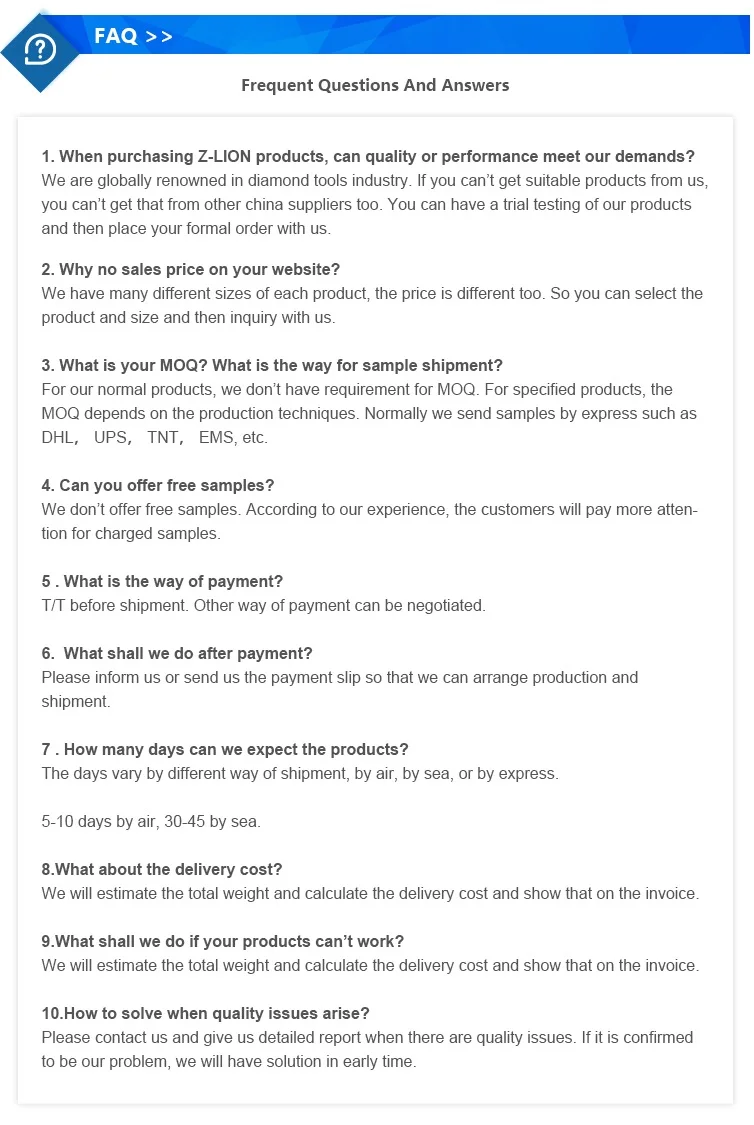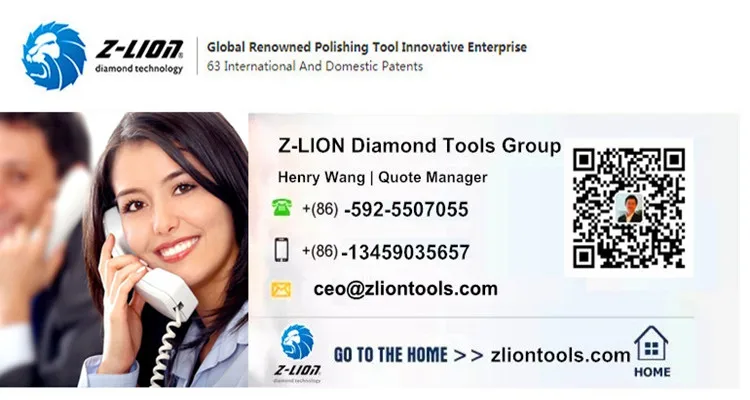Core Tip: Insufficient holding power and particle shedding in the electroplated diamond tool seriously rang the service life and efficiency of the tool. In this paper, a detailed description of the methods is carried out, and some potential methods are recommended, in order to have a comprehensive and systematic understanding of the improved methods of electroplated diamond tools.
Insufficient holding power and particle shedding in the electroplated diamond tool seriously rang the service life and efficiency of the tool. This paper reviews the methods developed in recent years to improve the performance of electroplated diamond tools. It is summarized into the following three categories: 1. Improve the properties of the coated carcass material, improve the support and bonding of the coating to diamond; 2. Improve the diamond and The contact area of the carcass eliminates the gap between the diamond and the coating; 3. The surface treatment of the diamond particles forms a chemical bond between the diamond and the coating. In this paper, a detailed description of the methods is carried out, and some potential methods are recommended, in order to have a comprehensive and systematic understanding of the improved methods of electroplated diamond tools.
0 introduction
Electroplated diamond tool

Due to its high hardness, high strength, high wear resistance and low coefficient of linear expansion, diamond is used to make diamond tools for the processing of hard and brittle hard-to-machine materials. The diamond tool is prepared by electroplating, and the loose diamond particles are fixed in the plating layer by electrodeposition of the metal, so that the diamond particles have the cutting ability. The diamond tool prepared by electroplating has low manufacturing temperature, avoids heat loss to diamond, and has simple production process, few equipments, short manufacturing cycle, convenient molding and repair. Therefore, electroplated diamond products have various tools such as grinding wheels, grinding heads, assorted files, boring cutters, dressing rollers, geological drills, reamers, internal and external cutting blades, reamer saws, etc., in machinery, electronics, construction, drilling, Industrial applications such as optical glass processing are widely used.
At present, when the diamond tool is prepared by electroplating at home and abroad, the main problem is that the bonding force between the plated carcass metal and the diamond particles is low, and the diamond particles are easy to loosen and fall off when subjected to the force, resulting in a short service life. The main reason for these phenomena is that the manufacturing temperature is low when the diamond tool is prepared by electroplating, so that the surface of the diamond particles is not easily infiltrated by the general metal, and not only a strong chemical bond is not obtained, but also a gap is often generated. In addition, due to the influence of the electroplating process, the limited type of diamond tool plating metal is limited to a small amount of metals such as nickel and chromium and their alloys. It is not as extensive as the type of metal used in hot pressing tools.
In response to the above problems, various measures have been taken to solve the bonding force between diamond and coated metal. This paper comprehensively introduces the methods developed in recent years to improve the performance of electroplated diamond tools and summarizes them, hoping to give a detailed and clear understanding.
1 Improved carcass material
The plating in the electroplated diamond tool supports and combines the diamond. It is called the carcass or matrix metal. It determines whether the diamond particles can fully exert the cutting effect. It is generally required to meet high hardness, high wear resistance and high performance. Performance requirements, so people first consider improving the diamond tool by improving the performance of the carcass material.
1.1 Alloying of carcass metal
Although a single coating (such as nickel) has a high strength, particularly toughness, it is generally low in hardness, so alloy plating is often used.
1.1.1Ni-Co binary alloy coating
Cobalt not only can high nickel metal strength (nickel-cobalt alloy carcass compressive strength is 1600MPa), but also high heat resistance of carcass metal, the strength limit of Ni-Co binary alloy carcass at 800 °C is 500MPa, can also improve the toughness of the carcass metal. Therefore, the Ni-Co binary alloy plating layer has become a widely used carcass material, but sometimes the hardness of the Ni-Co binary alloy plating layer is still insufficient, and the carcass is consumed quickly when processing a hard and highly abrasive material. Moreover, the Ni-Co coating can ensure high hardness and wear resistance only when the cobalt content reaches about 30%, and a large amount of expensive metal cobalt increases the cost.
1.1.2Ni-Mn binary alloy coating
Metal manganese is more capable of nickel shell hardness, strength and wear resistance than cobalt. The nickel-manganese carcass hardness is about 10 degrees higher than the nickel-cobalt carcass hardness of Rockwell (HRC). Although the content of manganese in the alloy is small, it has a great influence on the performance of the carcass. When the nickel-manganese carcass diamond drill bit is drilled in a hard and strong abrasive formation, the average life and aging are 55% and 30% higher than that of the nickel-cobalt tire drill, respectively. At the same time, the nickel-manganese carcass bit does not need high rotation speed and large pressure, which is beneficial to reduce. Material consumption reduces drilling costs. However, the Ni-Mn binary alloy coating is more brittle and easy to crack, which makes the working layer easy to break.
1.1.3 Ni-Co-Mn ternary alloy coating
The Ni-Co-Mn ternary alloy coating has a higher overall performance. The hardness is higher than that of Ni-Co, and the brittleness is lower than that of Ni-Mn, which is in line with the requirements of the electroplated diamond products for the carcass. The stone tool made of ternary alloy Ni-Co-Mn coating is sharper and more durable than the Ni-Co binary alloy coating, especially for hard stone. The ternary alloy coating Ni-CoMn is low in cost due to the saving of a large amount of expensive material cobalt. The mechanical properties of Ni-CoMn ternary alloy coatings can be adjusted over a wide range to meet the needs of a wider range of applications. However, when the Ni-CoMn ternary alloy coating is obtained, the composition of the plating solution is complicated and the stability is not easily controlled.
1.2 Composite of carcass metal
The composite plating layer is a special plating layer formed by uniformly interposing one or several insoluble solid particles and fibers into a metal plating layer by a co-deposition method. Due to the uniform dispersion of a large number of solid particles in the composite coating, these hard particles can greatly hinder the slip between the crystal grains and effectively strengthen the metal.
1.2.1Ni-Co fine-grained diamond composite coating
Adding appropriate amount of nano-diamond powder to the plating solution, the hardness of the obtained Ni-Co-diamond composite coating is obviously high, the hardness can reach 601.53 HV, and the friction and wear performance is remarkably high: the friction coefficient of the nickel-cobalt alloy coating is about 0.35, and the service life is When the friction radius is 14mm, the average is 0.022km; the friction coefficient of Ni-Co-dianond coating containing nano-diamond powder is about 0.3, and the coating life is 0.15km when the friction radius is 14mm. With the Ni-Co-dianond composite coated diamond bit matrix, the prepared diamond bit is drilled in a hard, strong abrasive formation with good wear resistance, fast bit length, long life, and can prevent hole inclination. Since the ultrafine diamond powder is easily agglomerated and its performance cannot be fully exerted, the diamond powder is dispersed by fingering. This inevitably restricts the use value and application prospect of ultrafine powder.
1.2.2Ni-Co rare earth element composite coating
The addition of a small amount of rare earth compound can improve the performance of the plating solution and the coating layer. In the electrodeposition process, the cation is mainly adsorbed on the surface of the metal deposit, and the rare earth metal ion exhibits strong adsorption on the electrode. The rare earth metal ions are easily adsorbed on the active point of crystal growth, that is, adsorbed on the growth point of the crystal plane, and the crystal growth is effectively suppressed. Therefore, after the rare earth element is added to the plating solution, a fine grain plating layer can be obtained. Using the universal cylindrical grinding machine M1420E through the grinding test of bright nickel plating and bright nickel plating diamond tool grinding with rare earth elements, it was found that the addition of rare earth elements improved the grinding ratio of the diamond tool. Bright nickel-plated diamond tools have poor wear resistance, fast carcass consumption, can not guarantee the high edge of diamond, and diamonds fall off quickly; the rare-earth bright nickel bond tool improves the wear resistance of the carcass, and the diamond package is better, the diamond blade height is higher. Large, so the efficiency of the tool is improved.
1.2.3Ni-Co-carbon nanotube composite coating
Carbon nanotubes (CNTs) have superior strength and toughness and can be used as reinforcements for advanced composites to greatly improve the strength and toughness of composites. In addition, CNTs have the characteristics of good chemical stability and low friction coefficient, and it is expected to prepare a new type of composite coating with high wear resistance, wear reduction and corrosion resistance. Observing the morphology of the composite coating, the surface of the substrate is covered by a thick layer of carbon nanotubes. One end of these carbon nanotubes is deeply embedded in the substrate, and the other end is exposed to the outside of the substrate, which obviously protects the substrate. effect.
1.3 Grain refinement of carcass metal
The crystallization process of the coating is governed by the nucleation rate and grain growth rate. The faster the rate of nucleation is formed, the slower the grain growth rate, and the finer the crystallization, the denser the coating and the better the hardness and toughness. According to the electrochemical theory, the larger the cathode electrochemical polarization overpotential, the easier it is to form crystal nuclei, and the finer the crystal, the denser the coating. Therefore, people have adopted the objective of improving the electrochemical polarization overpotential and refining the crystal grains to improve the carcass material.
1.3.1 Refined Additives
After the additive is added to the electrolyte, due to its adsorption on the electrode surface, the electrochemical polarization is increased, the covered crystal grains stop growing, and new crystal nuclei are generated; the new crystal grains are soon covered again, and a new nodule center is generated. So, you can get fine crystals. Secondly, the adsorption of the additive on the surface of the crystal can reduce the surface energy of the crystal, thereby reducing the formation of crystallites, which is favorable for forming a new crystal nucleus. The refining agent is mainly a sulfonic acid, a sulfinic acid, a sulfonamide or a disulfonic acid, and the like, for example, saccharin, p-toluenesulfonamide, benzenesulfinic acid, benzenesulfonic acid, sodium naphthalene disulfonate or the like. It can be found from the morphology of the surface of the coating before and after the addition of the aromatic ketone additive that the grain particles before the addition of the additive are large, and the crystallinity of the particles is poor, the crystal grains are loose, and the grain particles are significantly smaller after the addition of the additive, and The crystal is dense.
1.3.2 Ultrasonic method
The use of ultrasound enables the material to undergo intense mechanical vibrations and also produces a one-way force. When a certain frequency of ultrasonic waves passes through the liquid, the appropriate small bubbles of the ruler resonate. In the sparse phase of ultrasound, the vesicles rapidly expand and become larger; in the dense phase, the vesicles are suddenly compressed until they collapse. When the vesicle is suddenly compressed, the surrounding liquid fills the cavity at a great speed, and the nearby liquid or solid is subjected to high pressure of thousands of atmospheres, which is cavitation or cavitation. Electroplating using high current density under ultrasonic conditions makes the coating more compact, smooth, uniform in thickness, non-porous, well bonded to the substrate, and has high strength and hardness. Nickel plating in an ultrasonic field with a frequency of 16 kHz increases the hardness by 30% to 50%. Under appropriate process conditions, the internal stress of the coating can also be made lower than that of the coating without ultrasonic plating. The reason is that when the cathode current density is high to a certain value, the cathode polarization increases sharply, causing the hydrogen evolution to increase, the pH value rises, the nickel hydroxide solution appears at the cathode, and the cavitation of the ultrasonic wave refines the sol. And dispersion and stabilization to prevent sol condensation and precipitation. Ultrasonic waves should not be used in the whole process of diamond sand. It is only used in the thickening period. When the diamond abrasive grains are buried in a certain thickness of the coating, ultrasonic waves are used, and the diamond abrasive grains will not be shaken, which will not affect the sand of the diamond tools. number.
1.3.3 Pulse plating and nano-tire material
Pulse plating is a new type of plating technology developed in the 1960s. The electrochemical principle is based on: in one pulse period, when the current is turned on, the electrochemical polarization increases, the metal ions near the cathode region are fully deposited, and the plating crystal is fine and bright; when the current is turned off, the cathode region is nearby. The discharge ions return to the initial concentration and the concentration polarization is eliminated. Therefore, pulse plating is a new type of power application. The relaxation of the current or voltage pulse is used to reduce the concentration polarization of the cathode, thereby allowing higher current density to achieve higher electrode polarization and ultimately refining the grain. At present, electrodeposition technology has become an important preparation method for nanomaterials. These materials have high hardness and good toughness. When used to prepare diamond tools, the wear resistance of diamond tools can be significantly improved. Li Zhaomei et al. used the pulse electrodeposition method to prepare the nano-nickel diamond tool and tested it for wear and tear. The results show that the average life of the pulsed nano-nickel diamond tool is significantly higher than that of the conventional nickel-cobalt diamond tool, which is about 1.5 times.
2 Improve the contact area between diamond and carcass
2.1 Using surface roughened diamond particles
The roughening method is used to form some tiny pits and cracks on the diamond surface, and the surface of the diamond contact with the carcass is increased to improve the mechanical integration force of the diamond and the metal, and enhance the "mechanical anchor chain" effect. A strong roughening method is to cover the diamond with a fluorine-based salt (mainly NaCl+BaCl2) and a small amount of deoxidizing agent, cover with ceramic crucible, heat it in the furnace to 1000 ° C ~ 1100 ° C, then heat it, and then use The boiling water removes the fluorine-based salt. The diamond is heated, and the fluorine-based salt is melted to cause graphitization of the diamond corrosion, so that the surface forms minute and rough pits and cracks. Another weakening method is to etch the diamond in a roughening solution (nitric acid + sulfuric acid or nitric acid + hydrogen peroxide) at room temperature or under heating, without stirring, and then rinse with distilled water. The diamond will form some defects (such as pits, cracks) and slight graphitization under the corrosion of strong oxidizing acid.
2.2 Eliminate the gap between the diamond particles and the tire rest in the tool
Since diamond is a non-metal, it has no good affinity with metals, resulting in high interfacial energy between diamond and common metals or alloys, often creating voids and reducing the bonding between diamond particles and the substrate of the coating. In this case, the particle surface modification method, the CVD method, the ultrasonic method, or the electroless plating method can be utilized to avoid or compensate for such voids.
2.2.1 Particle surface modification method
The diamond particles are oxidized to form a hydrophilic chemical group on the surface, thereby improving the hydrophilicity of the diamond surface and tightly bonding the diamond particles to the plating layer. If the hydrophilic groups on the diamond surface are replaced by some more hydrophilic organic genes by chemical means, further high effects can be obtained.
2.2.2 Electroless plating
Electroless plating is to deposit a metal on the surface of diamond by an oxidation-reduction reaction of an autocatalytic process without an applied current, thereby forming a film coating having a uniform thickness and a dense thickness. It has been found that when a diamond tool is obtained by chemical composite plating, there is no gap between the diamond and the metal carcass. Accompanied by ultrasonic vibration, there will be expansion around the diamond particles, completely eliminating the gap. The particulate diamond can be directly electrolessly plated to obtain a tool which can be uniformly suspended in the plating solution. For large-grain diamonds, we recommend that you first perform electroplating and sanding, and let the diamond be pre-embedded in the coating.
3 Improve chemical bonding between particles and carcass
By treating the diamond, the carbon atoms on the surface and the metal atoms form metal/carbon chemical bonds, which can completely solve the problem that the diamond and the carcass bond strength in the diamond tool is not strong.
3.1 Surface metallization
The surface treatment of the diamond particles by electroless plating can form a firm and tight connection between the diamond and the coating. However, if the diamond surface is completely metallized, the surface of the diamond particles has good electrical conductivity and is not suitable for electroplating to prepare diamond tools. In the process of burying sand, the plated diamond and the steel substrate and the plating layer form a cathode together, and a plurality of diamond particles are bonded to each other to form a block. Therefore, the researchers used a diamond with dispersed conductive dots on the surface to make an electroplated diamond tool. The method is to control the degree of electroless plating on the diamond surface, strictly control the concentration of the sensitizing solution and the activating solution, and the time of sensitization and activation treatment, so that the number of metal dots on the diamond surface is kept within a proper range. Although the number of conductive dots on the surface of the diamond is increased, the connection point with the plated metal can be increased, and the bonding property between the plating layer and the diamond can be improved. However, when the metal dots are too dense, a thin layer of metal connected into a sheet is formed.
After the electroless plating of diamond, the obvious boundary between the diamond and the nickel-cobalt-based coating disappears, and some scattered nickel-cobalt joints are grown on the joint surface of the diamond and the coating. The electroplated diamond tool was prepared from the activated diamond, and the material removal amount was 1.5 times that of the unactivated treatment when grinding the Al2O3 ceramic workpiece. However, with this method, the chemical combination between the diamond particles and the coating may be only the original chemical bond, and the intermolecular force may account for a larger proportion.
3.2 CVD method
The diamond CVD deposition technology is used to repair the prepared diamond tools, which not only allows the newly formed diamond to be deposited in the gaps in the tool, but also allows the diamond particles in the tool to be regenerated, and the surface is further developed and thus high. Particle properties. The MPCVD method has been successfully used for void repair occurring between diamond particles and carcass metal after electroplating. The surface topography of an electroplated diamond tool prepared with 16 μm diamond particles with an average ruler was observed under SEM. Edge and surface irregularities were found, and there were concave surfaces and voids between the diamond particles and the carcass metal. By placing the tool in an MPCVD system, the average size of the diamond particles is increased to 25 μm. The gap between the diamond particles and the carcass metal is compensated by SEM and the surface of the diamond particles is regular and full. Repairing the electroplated diamond tool with this method has higher cutting force, wear resistance and particle bonding than the unrepaired electroplated diamond tool. At high temperatures during the MPCVD process, a carbon-metal bond is formed between the diamond and the carcass to create a strong bond between the diamond particles and the carcass metal.

-All diamond tools can be ordered and fabricated!
- Henry Wang | Quote Manager
Henry Wang | Quote Manager
-WhatsApp:+86-13459035657
-Email: ceo@zdiamondtools.com
-Web www.zdiamondtools.com
Company Profile
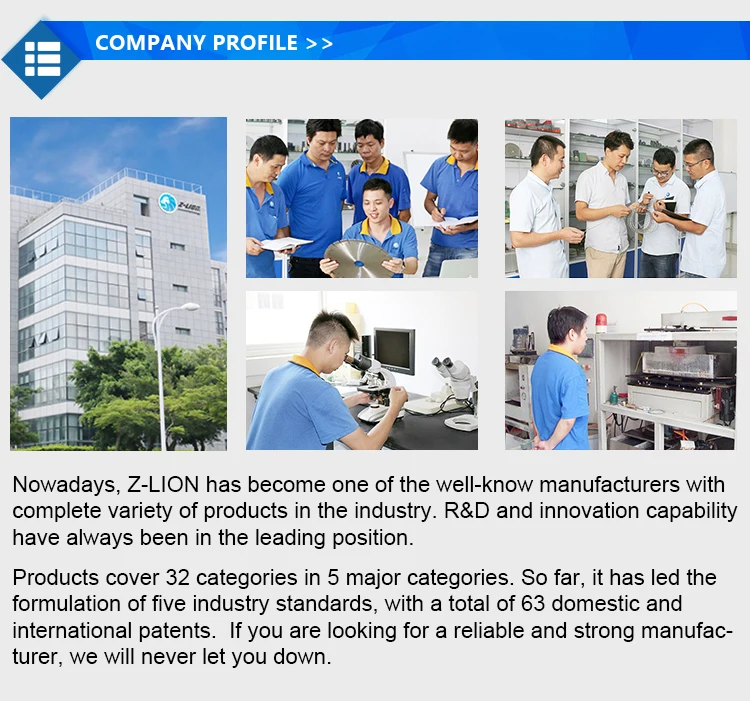
Certifications
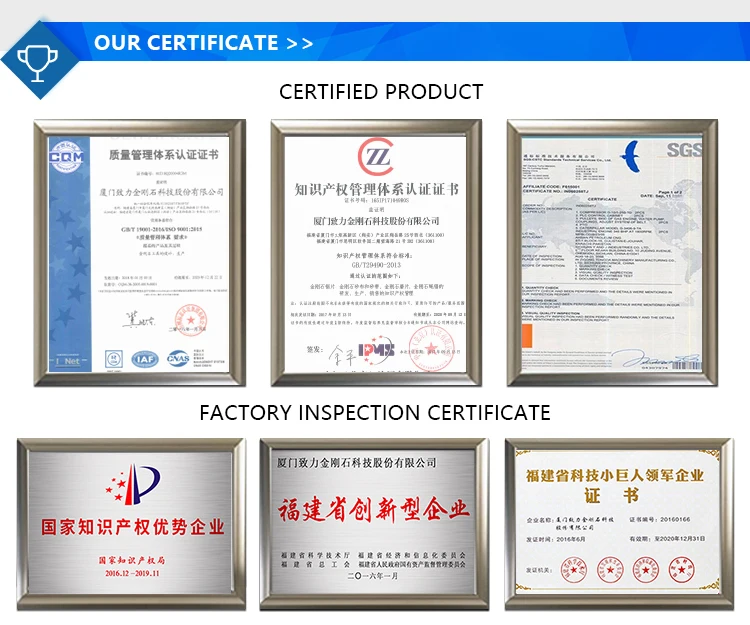
Company Team

Exhibition
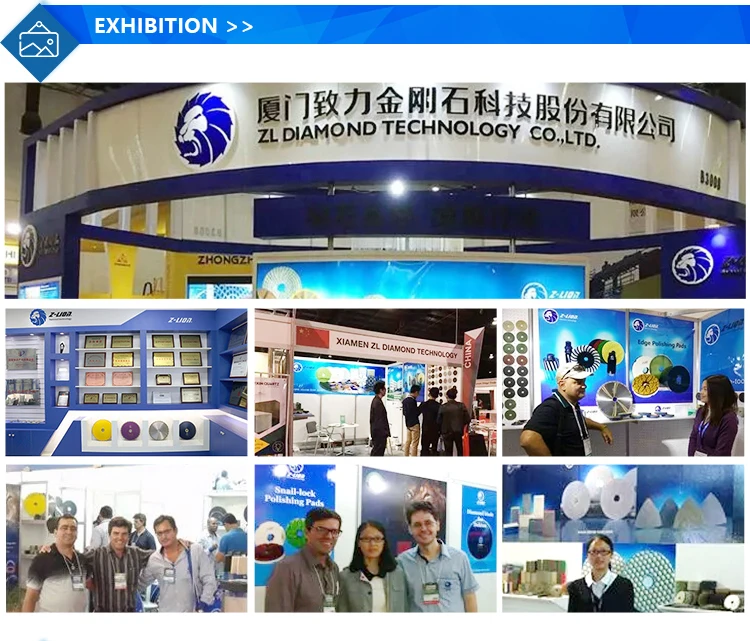
Logistics

FAQ
